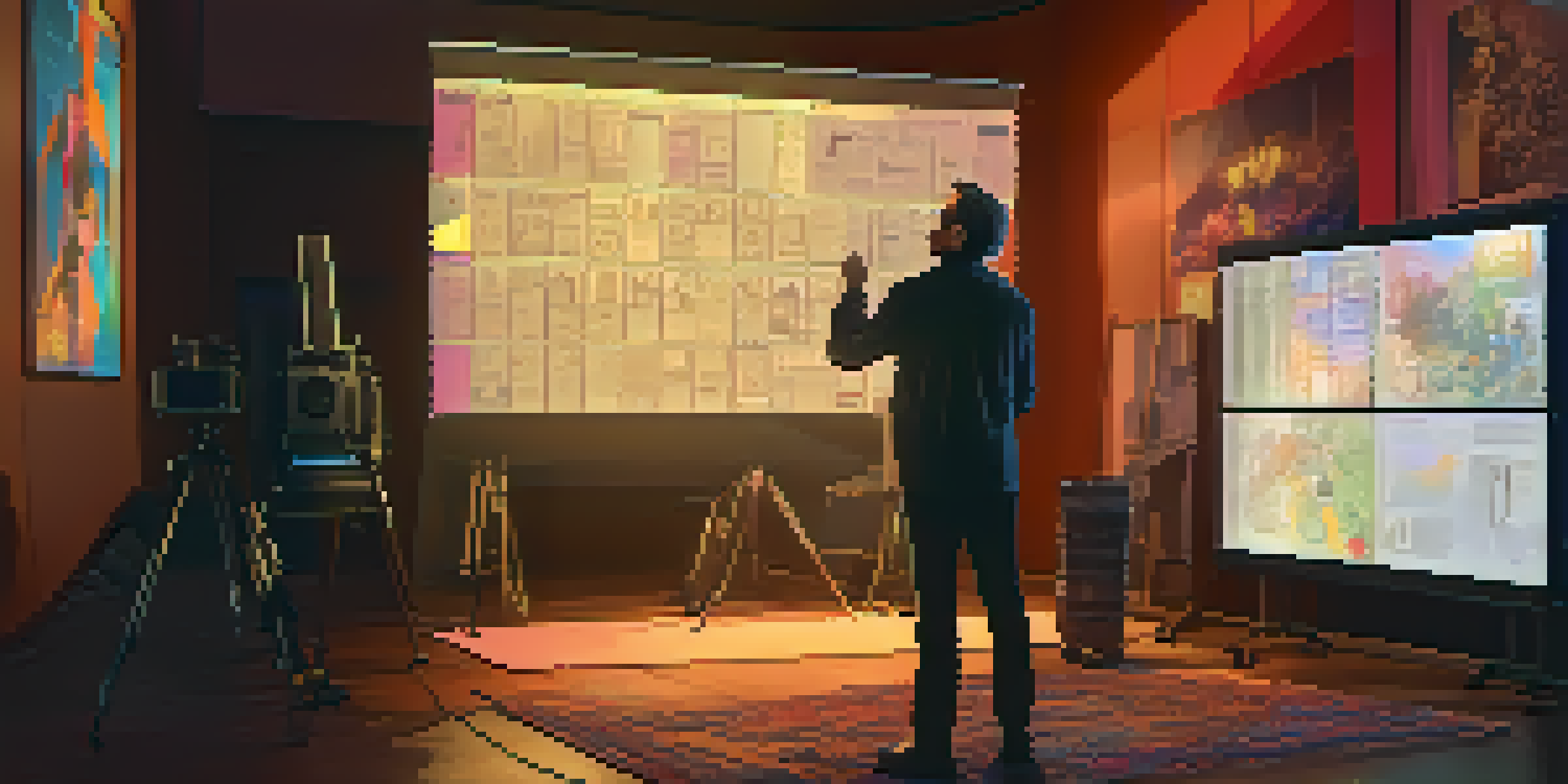The Role of Directors in Shaping Film Adaptations

Understanding Film Adaptations and Their Challenges
Film adaptations take stories from books, plays, or even games and reinvent them for the screen. This transformation can be challenging, as directors must balance staying true to the source material while making it appealing to a broader audience. They often face the task of condensing complex narratives into a two-hour film, which can lead to difficult decisions about what to include or leave out.
Adaptation is a form of translation, and translation is, above all, an act of interpretation.
Moreover, adapting a story isn't just about translation; it's about interpretation. Directors bring their unique vision to the material, which can change the tone, pacing, and even character development. For example, a director might choose to emphasize a character's internal struggles more than the original text, creating a different emotional experience for viewers.
Ultimately, a successful adaptation resonates with both fans of the original work and newcomers. It requires directors to have a deep understanding of the source material while also being innovative enough to present it in a fresh and engaging way.
The Director's Vision: Crafting the Film's Tone
A director's vision is crucial in shaping the overall tone of a film adaptation. This vision influences everything from the cinematography to the performances of the actors. For instance, a director known for their dark and gritty style may turn a light-hearted novel into a more somber film, providing a new perspective on the story.

This creative direction can be polarizing; fans of the original work might appreciate the new interpretation, while others could feel alienated by the changes. The key lies in the director's ability to maintain the essence of the original while infusing it with their unique artistic approach. Successful directors often find a balance that honors the source material while making it relevant to contemporary audiences.
Adapting Stories for the Screen
Film adaptations require directors to balance fidelity to the source material with the need for creative interpretation and audience engagement.
In the end, the tone set by the director can significantly impact how the story is received, influencing both critical acclaim and audience enjoyment. A well-crafted tone can elevate a film adaptation from a mere retelling to a compelling piece of art.
Casting Choices: The Director's Critical Decisions
Casting is one of the most significant responsibilities a director has when adapting a story for film. Choosing the right actors can make or break the believability of the characters, and thus the film's success. Directors often have to consider not just the talent of the actors but also how well they embody the essence of the characters from the original work.
The director is the captain of the ship, the one who steers the film towards its vision.
For example, if a director is adapting a beloved literary character, they might seek an actor who can capture their quirks and nuances without resorting to impersonation. This careful casting helps to create a connection between the audience and the characters, making the adaptation feel authentic and engaging.
Moreover, directors often collaborate closely with casting directors to ensure they find the perfect fit for each role. These casting choices can lead to standout performances that resonate with viewers, ultimately shaping how the adaptation is perceived and appreciated.
Visual Storytelling: How Directors Shape the Look
Directors play a pivotal role in visual storytelling, as they guide the film's aesthetic and visual language. They work closely with cinematographers, production designers, and costume designers to create a cohesive look that reflects the themes of the adaptation. This collaboration is essential, as visuals can convey emotions and ideas in ways that dialogue sometimes cannot.
For instance, a director might choose a specific color palette to evoke certain feelings or use particular camera angles to emphasize character dynamics. These visual choices enhance the narrative, allowing viewers to experience the story on multiple levels. A well-thought-out visual style can differentiate a film adaptation and make it memorable.
The Director's Vision Matters
A director's unique vision shapes the film's tone and can significantly influence audience reception and critical success.
Ultimately, the visual storytelling crafted by the director helps to create an immersive experience, drawing the audience into the world of the adaptation. This artistic vision contributes significantly to how the story is perceived and remembered.
Navigating the Balance Between Originality and Fidelity
One of the most challenging aspects of directing a film adaptation is finding the right balance between originality and fidelity to the source material. Directors often face pressure from fans who expect a faithful retelling while also wanting to bring their creative flair to the project. This tension can lead to debates around what constitutes a 'good' adaptation.
To navigate this balance, directors must make intentional decisions about which elements of the original story to preserve and which to adapt or change. For example, they might maintain key plot points or character arcs while altering dialogue or setting to fit a cinematic format. This flexibility allows directors to refresh the narrative while respecting the essence of the original work.
Ultimately, a successful adaptation strikes a balance that resonates with both new audiences and longtime fans. Directors who master this balance leave their mark on the film and contribute to a richer understanding of the source material.
Collaboration with Writers: Bringing Stories to Life
The relationship between directors and writers is crucial in shaping a successful film adaptation. Directors often collaborate closely with screenwriters to ensure that the film captures the spirit of the original story while also being suitable for the screen. This partnership allows for creative brainstorming, where directors can provide input on character development, dialogue, and scene structure.
Through this collaboration, directors can help writers understand their vision for the film, leading to a script that aligns with their artistic goals. This process often involves multiple drafts, with directors and writers working together to refine the script until it reflects both the original material and the director's interpretation.
Collaboration is Key
The partnership between directors and writers is essential in crafting a compelling adaptation that respects the original story while appealing to viewers.
Ultimately, this collaboration is vital not only for crafting a compelling narrative but also for ensuring that the adaptation resonates with the audience. A strong partnership between directors and writers can lead to adaptations that feel both fresh and respectful of the source material.
The Impact of Directors on Audience Reception
The influence of directors extends beyond the creative process; their decisions significantly impact audience reception. A director’s unique style and approach can attract diverse viewers, shaping how the film is marketed and perceived. For example, a well-known director with a distinct visual style may draw in audiences eager to see their interpretation of a beloved story.
Moreover, directors often engage with audiences through interviews, social media, and promotional events, allowing them to explain their vision and choices. This engagement helps build anticipation and can influence how viewers approach the film, whether they expect a faithful adaptation or a creative reimagining.

Ultimately, the director's role in shaping audience reception underscores their importance in the film adaptation process. Their vision and ability to communicate that vision can lead to a deeper connection with viewers, enhancing the overall experience of the adaptation.